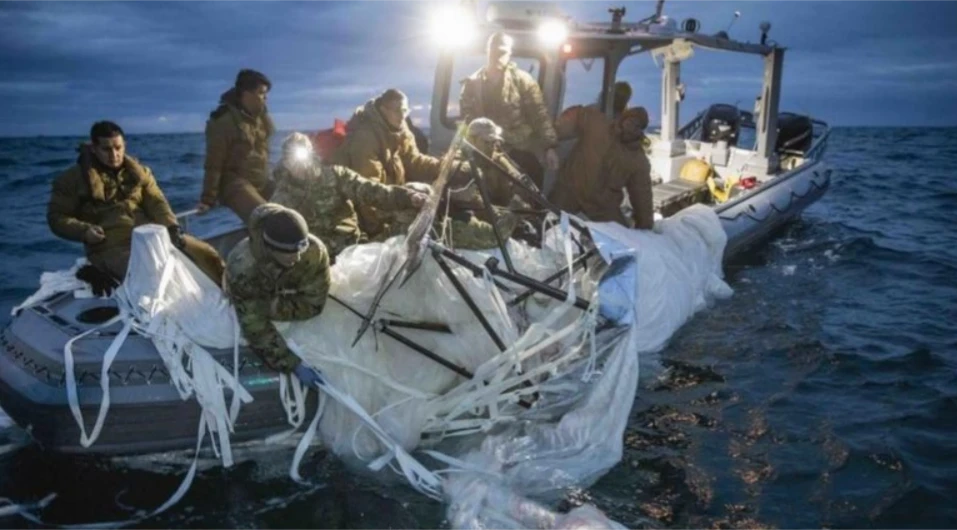In recent weeks, the U.S. military shot down four unidentified objects flying over North American skies, which has generated growing concern in Washington.
One senator even described the events as “nothing short of insane.”
But there are many unanswered questions. Here’s what we know and what we still don’t know.
How it all started
A large, high-altitude object was spotted on Jan. 28 as it passed over Alaska’s Aleutian Islands, an archipelago in the northern Pacific Ocean between the U.S. and Russia.
It was then tracked as it entered Canadian airspace before emerging over the western U.S. state of Montana.
On February 1, public attention was first focused on the object flying at high altitude after startled residents of the city of Billings, which had already closed its local airport, took photographs of the object.
Montana, a sparsely populated state, is home to one of three nuclear missile silo fields in the country, and authorities said the object was a suspected Chinese surveillance balloon that appeared to be monitoring sensitive sites in the region.
Officials said the object was more than 60 m high and was equipped with multiple antennas, solar panels and surveillance equipment capable of intercepting telecommunications.
But officials at first refused to shoot it down because of concerns about the damage that falling debris could cause, so it was allowed to drift across the continental U.S. for days.
On February 4, President Joe Biden authorized it to be shot down by an F-22 aircraft off the coast of South Carolina.
Recovery teams collected some debris and are using boats and mini-submarines in order to collect more equipment from the balloon, which is submerged approximately 14 m underwater.
China denied that the balloon was used for spying and indicated that it was a weather monitoring device that went astray.
The destruction of the balloon “seriously violated international practice,” Beijing said, adding that it reserved the right “to use necessary means to deal with similar situations.”
Alaska and Yukon
On Friday, February 10, U.S. forces shot down another object off the coast of northern Alaska.
Officials said it was “the size of a small car” and had been flying at 12,000 m as it traveled in the direction of the North Pole without any propulsion system or control.
The following day, on Saturday, February 11, a similar “high-altitude airborne object” was shot down on U.S. and Canadian orders over the Yukon Territory in northwestern Canada.
It is still unclear what these two objects were and reports give mixed descriptions.
Senator Chuck Schumer, the top Democrat in Congress, said on February 12 that intelligence officials believed both were balloons, “but much smaller than the first one.”
But when a U.S. Defense Department spokesman was asked about Schumer’s comments, he responded that the two objects “didn’t look much like” the original balloon.
And a senior official told ABC News that the more recent objects that were shot down were likely weather balloons and not surveillance devices.

The alleged Chinese spy balloon sighted over the city of Billings, Montana.
Unidentified Flying Objects – Chronology
February 4: The U.S. military shoots down a suspected surveillance balloon off the coast of South Carolina. It had been drifting for days flying over the U.S. Authorities said it came from China and had been monitoring sensitive sites.
Feb. 10: The U.S. shoots down another object off northern Alaska that officials said lacked any propulsion or control system.
Feb. 11: A U.S. fighter jet shoots down a “high-altitude airborne object” over Canada’s Yukon Territory, about 100 miles from the U.S. border. It was described as cylindrical and smaller than the first balloon.
February 12: US aircraft shot down a fourth high-altitude object near Lake Huron “as a precaution”.
Lake Huron
On Sunday, February 12, U.S. aircraft shot down another object as it approached Lake Huron, one of the largest in the Great Lakes, which straddle the U.S.-Canadian border.
This marked the third object shot down in three days and, like the previous two, it is unclear what it was.
Defense officials described it as an octagonal structure with threads hanging down. They said it was destroyed “as a precaution” because it posed a danger to civil aviation due to the height at which it was flying.
After the latest incident, the commander of the U.S. Air Force, charged with protecting U.S. airspace, indicated that he could not explain what the three most recent objects were, how they stayed aloft or where they came from.
And when asked about the possibility of extraterrestrial activity, Gen. Glen VanHerck noted that nothing had been ruled out.
Officials say U.S. radar systems, which are more equipped for fast-moving missiles than for hovering balloons, could detect more objects as the search continues.
“Now, of course, we’re looking for them. So I think we’ll probably be finding more things,” Congressman Jim Himes, the top Democrat on the House Intelligence Committee, told NBC News.
Recovery and reaction
There are several teams working to recover the wreckage.
Helicopters and transport planes have been deployed to the frozen ice of the Beaufort Sea off the northern coast of Alaska.
“Arctic weather conditions, including wind chill, snow and limited daylight, are a factor,” the U.S. Army said.
In the Yukon, Canadian CP-140 patrol aircraft are searching for debris from the third object.
Meanwhile, much of the original balloon has been recovered in the Atlantic Ocean and is being analyzed by FBI agents.
With the uncertainty there are increasing calls for White House and Defense officials to provide more information as soon as possible.
“We need information on where they originated, what their purpose is and why their frequency is increasing,” said Michigan Democratic Congresswoman Debbie Dingell.

